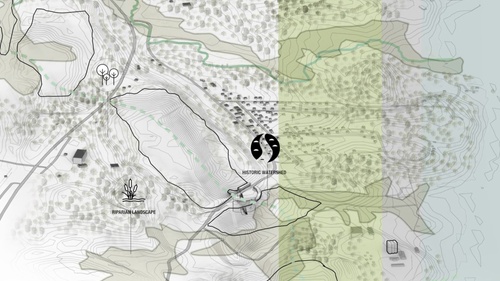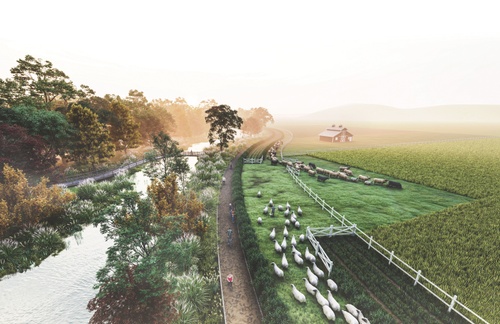Introduction
Urban Design
The Urban Design program engages the complex processes of global urbanization amid the emerging stresses of climate change. Ways of living in cities and landscapes around the world are increasingly untenable, and now require new forms of research and attention. What is the agency of design in these rapidly shifting conditions? The program frames the city not as a fixed, delineated territory but instead as a gradient of landscapes supported by networks of energy, resources, culture, mobility, and capital. It addresses near and long term threats to local, regional, and global ecosystems, positioning design as both an inclusive, activist, tools-based project for specific sites and communities, and as a critical project examining urban form, process, and knowledge. The following presentation of work from the 2019-2020 academic year illustrates the critical and creative ambitions that students brought to a variety of sites, scales, and audiences. Projects require multi-scalar analyses of urban-regional fabrics and infrastructures, as well as on-the ground interactions with communities and local conditions.

Urban Design Studio I and the Summer Semester
Metropolitan Transformation
Studio: Tricia Martin and Nans Voron, coordinators; Hayley Eber, Sagi Golan, Quilian Riano, Austin Sakong, Shin-pei Tsay
With Carmelo Ignaccolo, Kyle Hovenkotter, Jesse Hirakawa, Shuman Wu, Digital Techniques; Cassim Shepard, Jesse Hirakawa, Reading New York Urbanism; Noah Chasin, Amy Zhang, Caitlin Blanchfield, Urban Theory and Design in the Post-Industrial Age.
Urban Design Studio I consists of four courses that operate as an integrated design and research curriculum focusing on the New York metropolitan region. All work is based on the coordinated learning of concepts, working methods, historical precedents, research protocols, and representational strategies. Faculty and associates overlap, course times and subjects mix, and design agendas are tested in various settings. This teaching model demonstrates how the practice of Urban Design weaves together varied tasks of storytelling, community engagement, site survey and interpretation, filmmaking, digital visualization, mapping, and 3D modeling, all of which enable students to create urban knowledge and to iterate, represent and communicate design ideas. The core of the 2019 Summer curriculum is the neighborhood. For American metropolitan regions like New York, the neighborhood as contested social and physical territory is central to popular, journalistic, political, and design discourses. It is also a place of experience and emotion. The neighborhood-focus of the studio underscores our role in an ongoing process of change and through which you can rethink, reshape and regenerate an urbanism of the 21st century. In particular, working in post-industrial and climate-stressed conditions requires the critical interrogation and redefinition of multiple layers of existing and historic fabrics and infrastructures (in and beyond the neighborhood) in order to address the social life of current and future inhabitants.

Videos produced during the Reading New York Urbanisms course led by Cassim Shepard and Jesse Hirakawa
Urban Design Studio II
Defining the Region
Kaja Kühl, Studio Coordinator
Anna Dietzsch, Justin G. Moore, Jerome Haferd, Liz McEnaney, Shachi Pandey, Raafi Rivero, David Smiley, and Dragana Zoric
Urban Design Studio II operates at the regional scale, asking students to enter the discourse of urbanization beyond cities and to engage the uneven socio-spatial ecosystems that make up this dispersed landscape. The Hudson Valley, a region defined by multiple systems, histories, and geographies, demonstrates the tensions that result from its simultaneous autonomy from, and integration into, New York City, the global metropolis at its southern edge. The Fall Studio is therefore defined neither by political boundaries nor a physical area but, in the tradition of Patrick Geddes, the region is understood as the integration of settlements, modes of production and consumption, and the topographic and biological contexts in which they take place. Taking Geddes further into a biopolitical arena, the Regional studio also accounts for the means by which administration, policy, and stewardship are brought to bear in specific places, among specific populations, and at multiple scales. The Fall 2019 studio worked as part of a GSAPP-wide collaboration, along with the Buell Center, called “Public Works for a Green New Deal,” taking part in meetings and conferences.
Read the full report for the Fall 2019 Hudson Valley Regional Studio here.
STUDENT PROJECT FILMS
Migroculture
Industrial Agriculture in the US today operates in a way that is out of sync with both the lon...
Unboxed
The proliferation of shopping centers in the 1960s, and the highways that sustained them, are ...
Green it, Clean it!
Around 130,000 acres of land in the Hudson Valley have been contaminated by the direct and ind...
A Sentence Rewritten
The Green New Deal focuses on three primary goals: The eradication of carbon emissions, the pr...
Good(s) Shift: Revitalizing the Port of Newburgh
Trucks are one of the largest contributors to air pollution in the region, and function within...
Carbon Sequestration
A tree, as a carbon machine, can store huge amounts of carbon in its body, estimated to 217kg ...
Post Retail Scape Collaborative Main Street
With the global transition from traditional shopping to e-commerce and the change in consumer ...
Social Carbon
As it stands, the Green New Deal is lacking the practical tools to implement the grand goals t...
These Routes are Made for Walking
Decades of failed policies and speculation have enabled Sprawl to spread pollution across the ...
What’s on Your Plate? Food as Knowledge
Access to fresh produce is clear goal for communities seeking improved public health, and a lo...
Drive-less Life
The transportation sector contributes to 36% greenhouse gas (GHG) emission in New York State, ...
Dispersing Wellness
USA produces an estimated 6,456.7 million tons of CO2 every year. Healthcare industry accounts...
The Tech City Co-Op
The Building industry accounts for 30% of Global Carbon Emissions with 40% coming from product...

Quarryscape
Historically, industries dotted along the Hudson River had thrived and polluted the environmen...
Migroculture: German Bahamon, Claudia Kleffmann, Nina Lish, Nina Ndichu, Angus Palmer / Carbon Sequestration: Menghan Zhang, Tian Hao, Kuan-I Wu, Eleni Stefania Kalapoda / Unboxed: Hala Abukhodair, Scott Guo, Xinuye Liu, Stuti Ganatra / These Routes Are Made For Walking: Yile Xu, Jaime Palacios, Kunal Mokasdar, Lino Caceres / What’s on your plate? Food as knowledge: Annie Wu, Moneerah Alajaji, Vasanth Mayilvahanan, Wei Zhang / Dispersing Wellness: Mansoo Han, Niharika Shekhawat, Shailee Shah, Ting Zhang / A Sentence Rewritten: Aasiya, Zhen Hua, Yuan Qin, Alvi Khan / Drive-Less Life: Shuo Han, Isabella Zhang, Yao Yao / Post Retail Scape: Chris Zheng, Hatem Alkhathlan, Einat Lubliner, Sushmita Sheker / Social Carbon: You-Chiao Wu, Mary Elizabeth Allen, Minjung Lee, Candelaria Mas Pohmajevic / QuarryScape: Zhou Wu, Palvasha Sophia Khan, Nikita K, Ashwin Nambiar / Green it, Clean it!: Anai Perez, Danwei Pan, Pratibha Singh, Zixuan Zhang / The Tech City Co-Op: Victoria Vuono, Laszlo Kovacs, Sophie Lee, Ritchie Ju / Good(s) Shift: Antonia Medina Abell, Hugo Bovea, Tal Fuerst, Sharvari Raje
Urban Design Studio III
Global Cities and Climate Change
Kate Orff, Coordinator
Lee Altman, Adriana Chavez, Dilip da Cunha, Fitsum Gelaye, Geeta Mehta, Thad Pawlowski, and Julia Watson
Urban Design Studio III investigates the process of urbanization in a global context, examining sites facing substantive social and climate change including, most recently, Pune and Varanasi, India, Can Tho, Vietnam, and Aqaba, Jordan. Studio research moves beyond the legacy of urbanism characterized by binaries such as city and countryside, urban and rural, or city and suburb and instead frames urbanism as a continuously shifting assembly of socio-natural systems. In particular, the studio focuses on the water-energy-food nexus in which spatial dynamics are inseparable from the uneven effects of climate change, landscape and ecological degradation, destabilization of housing systems, threats to public health, challenges to work patterns, and the transformation of mobility. Students explore the operative potential of multi-scalar, ecological frameworks for designing robust urbanized landscapes and public spaces. The studio is organized with the intensive participation of local partners, from city governments and planning departments, to humanitarian groups, local universities and community NGOs. The Studio produces exhibitions and public events with project partners and, as the final studio in the Urban Design sequence, students organize a publication documenting process, partnership findings and design proposals.
The Great Rift Valley marks a global transect along geological fault lines. It’s an active space of movement and exchange spanning watery crevices and fertile landscapes from the Jordan River Valley in the Middle East to the Zambezi Delta in Mozambique. The tectonic plates underlying the Rift are pulling away from each other, and expanding socio-political fractures on the surface follow suit. The 2020 spring semester Urban Design Studio explored how three cities along the Rift—Tel Aviv-Yafo, Israel; Addis Ababa, Ethiopia; and Beira, Mozambique—might forge systems and spaces to span this divide amid rapid urbanization and while grappling with the unique impacts of the climate crisis. Student design projects imagined creative alternatives to address the interrelated risks faced by vulnerable populations. These include extreme heat in Tel Aviv, flash flooding due to river floodplain development in Addis Ababa, and coastal inundation and disaster recovery in Beira, which was struck by Cyclone Idai in 2019. Marked with fossil evidence from the beginning of human civilization, the Great Rift Valley encourages bold thinking about the Earth’s next 100 years of habitability and urban design response.
Well House Renaissance: Danwei Pan, Kuan-I Wu, Tian Hao, Zixuan Zhang / Social Solar: Hugo Bovea, Kunal Mokasdar, Nina Ndichu, Sharvari Raje / MuşaHousing: Angus Palmer, German Bahamon, Palvasha Sophia Khan, Vasanth Mayilvahanan / Daylighting Neve Sha'anan: Antonia Medina Abell, Niharika Shekhawat, Candelaria Mas Pohmajevic, Shailee Shah
Trilateral Connection: Shuo Han, Yuan Qin, Zhen Hua, Zhou Wu / Traversing The Rift: Tal Fuerst, Claudia Kleffmann, Laszlo Kovacs, Victoria Vuono / Akaki Regional Trust: Sophie Lee, Minjung Lee, Hala Abukhodair, Eleni Kalapoda / ReciproCITY: Anai Perez, Mary Allen, Moneerah AlAjaji, Nikita K
Greening the Port Economy: Annie Wu, Chris Zheng, Isabelle Zhang, Mansoo Han, Ritchie Ju / Seeding the Machmaba: Ashwin Nambiar, Jaime Palacios, Joy You-Chiao Wu, Ting Zhang, Xinyue Liu / Re-defining Capital: Sushmita Shekar, Einat Lubliner, Hatem Alkathlan, Pratibha Singh / Aliança para uma Beira Construtiva: Yile Xu, Nina Lish, Wei Zang, Stuti Ganatra, Lino Caceres / Living Coastline: Scott Guo, Alvi Khan, Menghan Zhang, Yao Yao
Great Rift Valley Mapping Project: Aasiya Maaviah
Class of 2020
Master of Science in Architecture and Urban Design: Portfolio Index
The following is an index of portfolios submitted by graduating students from the Master of Science in Architecture and Urban Design program. These include projects completed during the Summer 2019, Fall 2019, and Spring 2020 semesters.
A-L
M-Z








































































